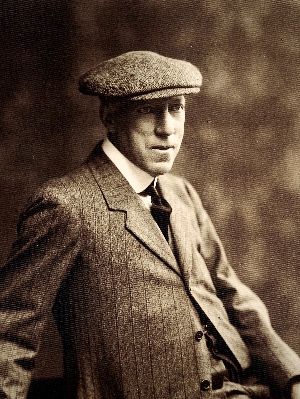Wright, George
Dancer
Collection date: Jun 1908
Area: Derbyshire
George Wright (1837-1916) of Wensley village, nr Matlock, Derbyshire: On 25/26 June 1908 George, age 71, who was a fiddler, played 8 country dance tunes (FT1698, 1708-14) to Sharp as well as the processional tune used by the Winster morris men (FT1715). Wensley is just over a mile E of Winster village and George would have known the morris men, many of whom were lead miners (as he had been in his youth) at the nearby Millclose Lead Mine.
George was a musician, playing fiddle at social dances and as an accompaniment to Maypole ribbon dances (see below). He was not the musician for the Winster morris men when Sharp saw them. That musician was Henry Hardy (1858-1917), a lead miner all his life.
Wensley village was very close to Cowley Hall, Darleybridge where Kitty Sorby (one of Sharp’s intermediaries) was brought up. Her father was a farmer there (see her profile). She had already sent Sharp a ‘Derbyshire Morris Tune’ (FT1148) in 1906 and then in March 1908 she sent him George Wright's notation of a ‘Maypole Dance’ (FT1403). Kitty encouraged Sharp to visit George Wright as soon as he could - https://archives.vwml.org/search/all:combined/0_50/all/score_desc/George%20Wright%201908%20Sharp
According to the sequence in his field note book (tunes)*, Sharp paid one quick visit to George Wright to make his acquaintance and collect just one tune - 'The man who couldn't get warm'. Next he visited the Winster morris men as they rehearsed on 25 June 1908, in preparation for their public performance during Wakes Week on 4 July. He collected the tunes and figures of 4 morris dances – The Processional (or March); The Gallop; The Reel; and the Blue-Eyed Stranger (FT1694-7). The figures are described in full detail in FW1535-48 and the Winster processional dance was then published in Morris Book 3 (1909 p43). Next day he went to collect 9 singing games from the Winster schoolchildren to add to his collection begun in Somerset in 1906. Finally he found George Wright again and noted the remainder of his country dances. Sharp published Wright's tune (FT1708) for the Tink a Tink dance in the (first) Country Dance Book in Dec 1909.
*Sharp's field notes for Winster are held at vwml.org in London: search CJS1/9/2/1908/4 pp15-23
George Wright was born on 14/1/1837 and baptised at Darley church on 5/3/1837. He was the only child of George Wright Snr, a lead miner, and his wife Sarah. Lead mining had gone on in this area since Roman times and steam power had enabled deeper mines to be dug and thus prolong the industry. George Jr began mining like his father but became a railway labourer by 1881 and then a quarry man and general labourer. He married Ellen Marsden in April qr 1880 (7b 1017) and they had 7 children. George lived his whole life in Wensley and died October qr 1916 aged 79 (7b 925).
Note 1: Sharp in fact returned on 4 July 1908 to see the Winster festivities, which included 'the braiding of the Maypole'.** Whether George Wright accompanied on fiddle was not recorded. The Winster morris dances must have somewhat puzzled Sharp. They were what Lionel Bacon called ‘intermediate between Cotswold Morris, North West Morris and Country Dancing’ (Bacon ‘Handbook of Morris Dancing’ EFDSS 1974 p314). For a start, there were 16 dancers, not 6; the dancers had no bells and no sticks; and there were extra characters – a King, Queen, Witch and a Fool.
**The Belper News 10 July 1908 reported on the celebrations.
Note 2: Sharp’s understanding of morris dancing was still in its early stages in June 1908. He, of course, knew the Headington Quarry style well and had seen it promoted by the Esperance Club girls for over 2 years. In his first Morris Book (April 1907) he had helped to draw up the first principles of morris stepping and figures, presenting 8 Headington dances and 3 Bidford dances. However, he had not yet met George Simpson of Sherborne (July 1908), William Wells of Bampton (Aug 1909) nor Henry Taylor of Longborough (May 1910), who would greatly improve his knowledge and technical grasp.
For more information about Winster morris, see Ian Russell article on the Winster centenary celebration in English Dance & Song magazine 2008 70/2 pp16-18. Also his 16mm film (made with Barry Callaghan): 'This is Morris Dancing: The Derbyshire Traditions of Castleton, Tideswell and Winster' Garland Films 1982.
For information on the Winster morris today, see https://www.winstermorrisdancers.org

